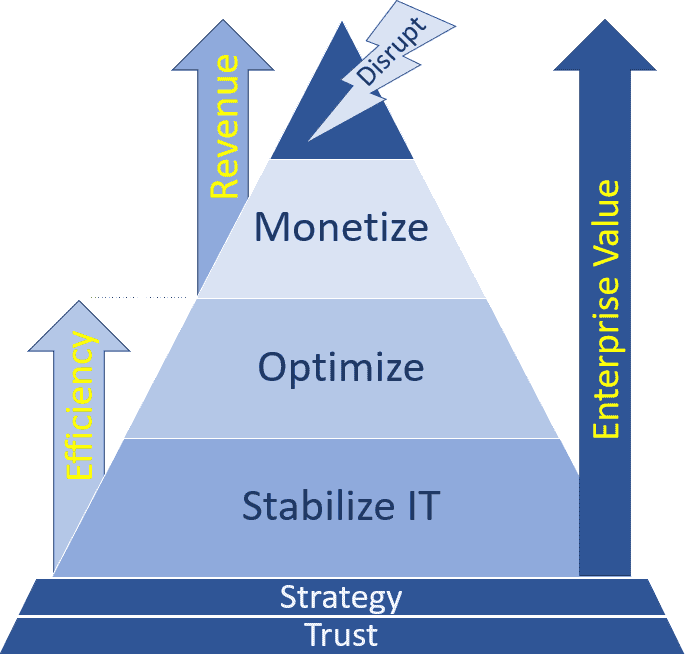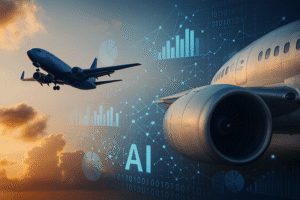Aerospace IT & AI Consulting
Proven Tech Leaders with Track Records in the Aerospace Industry
Aerospace IT & AI Experts
The aerospace industry has always been at the cutting edge of technology — from the dawn of flight to today’s innovations in private space exploration and satellite communications. With complex regulatory environments, high safety demands, and rapid shifts in fuel, sustainability, and consumer expectations, IT plays a mission-critical role in every aspect of aerospace.
Through our flagship Contract CIO+® tech leadership service and our foundational CIO IQ® IT & AI Advisory offering, Innovation Vista provides independent vendor-neutral IT & AI strategy to the Aerospace industry. Our consultants bring both deep technical knowledge and real-world experience guiding IT in airlines, manufacturers, airports, defense, and space organizations. We understand where general IT practices work — and where aerospace requires highly specialized strategies, such as regulatory compliance, redundancy planning, or enabling advanced analytics for engineering and logistics.
Unlike firms that assign generalists, our experts have served as CIOs and technology leaders within aerospace organizations. With Contract CIO+®, the objective extends beyond stabilizing and optimizing IT — it’s about ensuring technology strengthens safety, accelerates innovation, and enables growth in one of the most demanding and highly scrutinized industries in the world.
State of Innovation in Aerospace
Our 2025 Summary of Innovation in the Aerospace industry
The aerospace and defense industry is leveraging cutting-edge innovations to meet rising demand for air travel and heightened defense needs, all while tackling challenges like carbon emissions. Automation and AI are key drivers: aerospace firms are increasingly using AI for everything from optimizing manufacturing processes to enhancing flight safety. AI can power autonomous drones and vehicles, assist pilots with decision support, and even help manage air traffic more efficiently.
One notable 2025 trend is aerospace companies using AI and machine learning to analyze vast data (from sensors on engines, weather, etc.) to improve maintenance scheduling and fuel optimization. For example, AI can recommend optimal flight altitudes or engine settings that save fuel and reduce wear. Another major thrust is decarbonization; the industry is committed to reducing its carbon footprint over the coming decades. This involves developing sustainable aviation fuels (SAFs) and exploring new propulsion technologies like electric or hydrogen-powered aircraft.
Aerospace manufacturers are also employing digital tools (like digital twin simulations and smart factory methods) to design lighter, more efficient aircraft that burn less fuel. Additive manufacturing (3D printing) has become integral as well – aerospace is one of the biggest adopters of 3D printing, using it to produce lighter components, rapid prototypes, and even parts of rocket engines. This not only speeds up production but also reduces material waste and can improve performance (lighter parts mean improved fuel efficiency).
The sector is additionally seeing the rise of advanced air mobility: companies are testing electric vertical takeoff and landing vehicles (eVTOLs) and cargo drones that could transform urban transport and logistics in coming years. In aerospace workforce training and operations, immersive technologies like AR/VR are used for pilot training, maintenance guidance, and even assembly assistance on the factory floor, improving accuracy and reducing errors.
Finally, the satellite and space segment is booming – thanks to cheaper launch costs and demand for global connectivity, we see trends like miniaturized satellites, satellite IoT networks, and advanced propulsion systems for deep-space missions. So clearly, aerospace is innovating on multiple fronts: adopting AI and automation for efficiency and safety, aggressively pursuing greener tech to decarbonize air travel, and expanding the frontiers of flight with new mobility solutions and space technologies.
Aerospace Leaders First - Then Tech Leaders
Our Unique "Top-line ROI" Approach to Aerospace Technology
Many consulting firms focus only on Stabilizing IT systems, reinforcing cybersecurity, and Optimizing infrastructure and budgets. While vital, those steps alone are insufficient in aerospace — where compliance, safety, and reliability are non-negotiable and where innovation can determine competitive survival.
With Contract CIO+® and CIO IQ®, we align technology strategy with your organization’s mission. For a commercial airline, that may mean enhancing operational systems to reduce delays and improve customer satisfaction. For a manufacturer, it could involve integrating advanced engineering platforms and digital twins. For a space exploration or satellite company, priorities may include scalability, secure communications, and cutting-edge analytics. Each segment of aerospace has its own demands, and the IT roadmap must reflect them.
Where we add the greatest value is in Monetizing technology. We help aerospace leaders Innovate Beyond Efficiency® by identifying ways IT and data can generate business advantage — from predictive maintenance that reduces downtime, to digital platforms that improve supply chain resilience, to analytics that accelerate R&D cycles. In aerospace, technology isn’t just a support system — it is a catalyst for safety, efficiency, and groundbreaking innovation.
IT & AI Strategy for Your Aerospace Niche
Aerospace & Defense Sectors Covered
- FAA, DoD, NASA, EPA compliance
- Airports
- Airport & aircraft services
- Commercial airlines
- Air freight
- Aircraft manufacturing
- Private aviation
- Satellite communications
- Satellite imagery
- Space exploration
- Space tourism
- Military applications
- Aerospace specialty software & models
Latest Aerospace Tech !nsights from Our Team:
Analytics Maturity in Aerospace · Analyzing our Mid-market Survey
As we know well from our Aerospace IT & AI consulting, it is one of the most complex environments of the mid-market: capital-intensive, highly regulated, and safety-critical. The industry generates massive data volumes from sensors, IoT, and telemetry across aircraft and supply chains. This creates both opportunities and challenges: while data capture is abundant, integration and monetization are harder to achieve given long product cycles and risk-averse cultures. The recent update to our Mid-market Analytics Maturity Survey provides a clear view of how Aerospace companies are maturing across Data, Business Intelligence (BI), and Artificial Intelligence (AI). They also reveal how the sector compares to mid-market averages and to leading industries like Financial Services and Retail. Data Maturity in Aerospace



